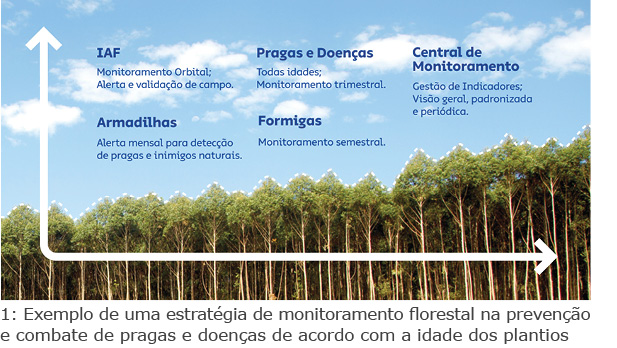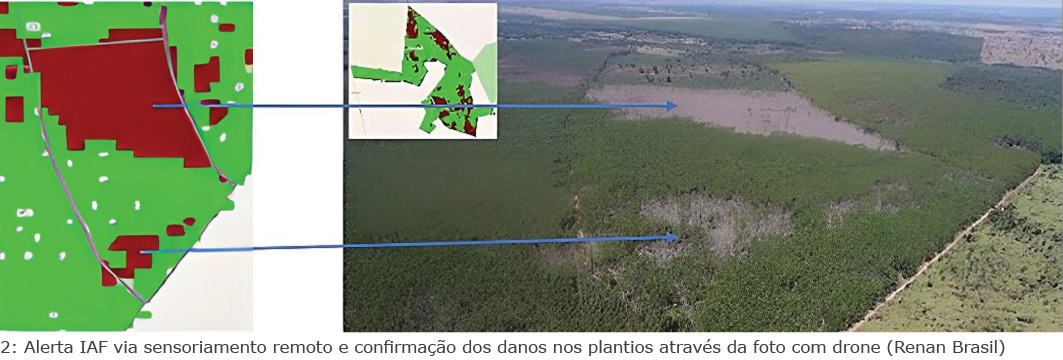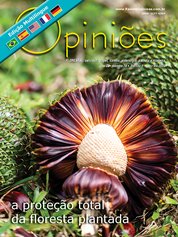Edmilson Bitti Loureiro
Gerente de P&D da Suzano
OpCP70
Monitoramento de pragas e doenças
Você não gerência o que não conhece. Assim, o monitoramento florestal deve ser utilizado como uma ferramenta de gestão para garantir a produtividade dos plantios frente ao ataque de pragas e doenças, permitindo mapear áreas de hotspot e planejar o controle biológico com a liberação de inimigos naturais.
Algumas estratégias de monitoramento de pragas e doenças:
Monitoramento terrestre de formigas cortadeiras: Por ser a principal praga florestal do Brasil, o monitoramento de formigas cortadeiras se consolidou como um case de sucesso, sendo pioneiro na estratégia de manejo integrado de pragas. Implantado há mais de 40 anos para viabilizar a aplicação do porta-isca (recipiente para proteger a isca formicida até que seja consumida pelas formigas), o monitoramento se tornou a principal ferramenta no manejo das formigas cortadeiras, garantindo otimização de recursos e proteção dos plantios de eucalipto, sendo utilizado pela maioria das empresas florestais.
 Mesmo em regiões com histórico de baixa ocorrência, é possível haver perdas significativas de produtividade causadas pelo ataque das formigas, se não manejadas adequadamente. Em função do histórico de danos severos, como retrata a frase dos anos 1930? “ou o Brasil acaba com a formiga ou a formiga acaba com o Brasil”?, ainda hoje é comum a prática do controle anual. Contudo, com as informações obtidas a partir da realização do monitoramento, é possível ficar um, dois ou até três anos sem intervir; por outro lado, uma intervenção anual pode não ser suficiente, sendo necessário adotar medidas adicionais. Dessa maneira, é possível otimizar recursos e tomar ações de controle mais assertivas.
Mesmo em regiões com histórico de baixa ocorrência, é possível haver perdas significativas de produtividade causadas pelo ataque das formigas, se não manejadas adequadamente. Em função do histórico de danos severos, como retrata a frase dos anos 1930? “ou o Brasil acaba com a formiga ou a formiga acaba com o Brasil”?, ainda hoje é comum a prática do controle anual. Contudo, com as informações obtidas a partir da realização do monitoramento, é possível ficar um, dois ou até três anos sem intervir; por outro lado, uma intervenção anual pode não ser suficiente, sendo necessário adotar medidas adicionais. Dessa maneira, é possível otimizar recursos e tomar ações de controle mais assertivas.Sensoriamento remoto na detecção de pragas e doenças: Com o avanço nas tecnologias de imagens de satélite, o monitoramento orbital tornou-se uma importante estratégia para enfrentar esses desafios.
Os danos causados por pragas e doenças apresentam, em sua grande maioria, um sintoma único comum: perda de área foliar. Assim, seria interessante monitorar o Índice de Área Foliar (IAF), que mede, de maneira precisa, a densidade de folhas de uma árvore, sendo um importante indicativo da qualidade florestal. O acompanhamento periódico do IAF em 100% das áreas produtivas com idade acima de um ano permite a detecção de mudanças na cobertura superior da floresta, indicando a adoção de medidas interventivas, como a priorização das vistorias terrestres.
As áreas com baixo índice de área foliar deverão ser confirmadas por validações de campo, que poderão ser utilizadas também para aperfeiçoamento e calibração da ferramenta para diferentes condições e ambientes florestais. Vale destacar que não existe uma única regra aplicável de forma automática para todo o setor florestal. Além do monitoramento orbital, o uso de drones vem sendo cada vez mais aplicado na confirmação dos eventos e delimitação da área afetada, podendo, inclusive, ser utilizado no manejo de pragas e doenças com a aplicação de defensivos ou até mesmo na liberação de inimigos naturais.
Além da coleta dos dados, é necessário criar uma rotina de análise das informações com acompanhamento de indicadores e gestão do seu ativo florestal em relação a pragas e doenças. Além da decisão do dia a dia, é fundamental olhar para os dados históricos e trabalhar nas lições aprendidas, para evitar perdas na produtividade dos plantios.





